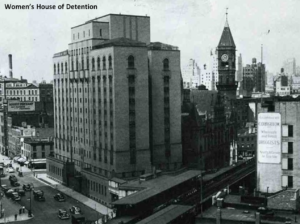 Ethel Rosenberg did time here. So did Angela Davis and Afeni Shakur. Andrea Dworkin endured its notorious cavity search and, with the help of Grace Paley, publicized this barbaric practice. You won’t find their names on a plaque at the site of The Women’s House of Detention on Greenwich Avenue. Nor will you find the names of the thousands of women whose lives were forever changed by this “high-rise Alcatraz”. But, at long last, Hugh Ryan has written a book which commemorates, and even celebrates their lives and, in the process, reveals an alternative Queer history which is at once, timely and essential.
Ethel Rosenberg did time here. So did Angela Davis and Afeni Shakur. Andrea Dworkin endured its notorious cavity search and, with the help of Grace Paley, publicized this barbaric practice. You won’t find their names on a plaque at the site of The Women’s House of Detention on Greenwich Avenue. Nor will you find the names of the thousands of women whose lives were forever changed by this “high-rise Alcatraz”. But, at long last, Hugh Ryan has written a book which commemorates, and even celebrates their lives and, in the process, reveals an alternative Queer history which is at once, timely and essential.
To tell this history, Mr. Ryan delves into a rich trove of social worker notes. You won’t learn their last names, but you’ll learn their life stories, both before and after their stays here. Some thrived after their release. Others couldn’t survive the trauma and the stigma. Some found love here. In the nineteen-fifties, an attempt was made to segregate queers in this prison, but it ended up being just a means to punish butch, transmasculine and other “trouble-making” inmates. Segregation was never really an option. Because, as one activist later explained, “There were just too many of us.”
The fifty-year history of this building is a New York history, a Greenwich Village history, a Queer history. And Mr. Ryan covers all of these thoroughly. Like most major civic projects, The Women’s House Of Detention was founded on the highest of ideals. It was to be a jail (not a prison where women had been convicted of crimes). It included a state-of-the-art hospital on site. Its exterior (at least) was beautiful, with Art Deco fenestration specifically designed to make the prison windows seem larger than the actually were. It was designed by Sloan and Robertson, the architecture firm that designed The Chanin Building. Social feminists and psychologists strongly supported the project.
But Mr. Ryan includes a telling detail: the cornerstone was laid on the day of the 1929 stock market crash. With the Depression came the inevitable belt-tightening. It began serving as both a prison and a jail–mixing convicts with those who have not yet been tried. And it soon became over-crowded. The hospital shrank to make room for more “dormitory style” housing. Outside, the gender-bending nightclubs of the Village were closing–victims of police harassment in a less permissive age. And then bizarrely, The Women’s House of Detention became a tourist attraction. The sight of sex workers getting booked and charged competed with Chop Suey in Chinatown for a cheap night out.
Mr. Ryan painstakingly and methodically illustrates how a minor offense–or no offense at all–could land a woman here. The Vagrancy Prostitution Act was widely abused by the police. Women were arrested for walking without being accompanied by a man. Transmasculine persons were targeted. Black women were far more likely to be arrested than white women–and the prison’s population reflected that. When you add in the number of women being held because they couldn’t make bail, it isn’t difficult to conclude that the majority of these women shouldn’t have been there at all.
In the nineteen fifties the population of The Women’s House of Detention changed from majority “prostitution” related to majority drug related. It is ironic that the prison administrators’ solution to this problem was Thorazine. In one of the book’s most shocking revelations, the author documents just how much the inmates were doped up. Thorazine was prescribed for stress. And on at least one occasion, Thorazine was prescribed for the common cold. What was left of the prison’s hospital became a dispensary for this wonder drug. The near-universal prescription of Thorazine in this particular women’s prison was, of course, not accidental. With The DSM adding homosexuality to its prescribable maladies in 1952, why not try Thorazine? Electric Shock treatment was already in use. Why not Thorazine?
Stonewall was, of course, just down the street from The Women’s House of Detention. Many queers quickened their step as they walked past it. You could hear the screams. And there were stories of things being thrown from this eleven-story tall prison. Even matches. And yet, increasingly, some queers on the outside were paying attention to what was happening on the inside. By the end of the nineteen-sixties the Gay Liberation Front declared closing this prison one of their highest priorities. Conversely, Angela Davis and Afeni Shakur galvanized the women on the inside to realize that the revolution that was happening outside included them too.
Mr. Ryan is wise not to over-stress the many issues in this book which resonate today. That is left to the reader. Needless to say, recent current events have made these issues more relevant than ever.
QueerReader.com strongly recommends this important book.
Hugh Ryan’s The Women’s House of Detention: A Queer History of a Forgotten Prison is published by Bold Type Books.